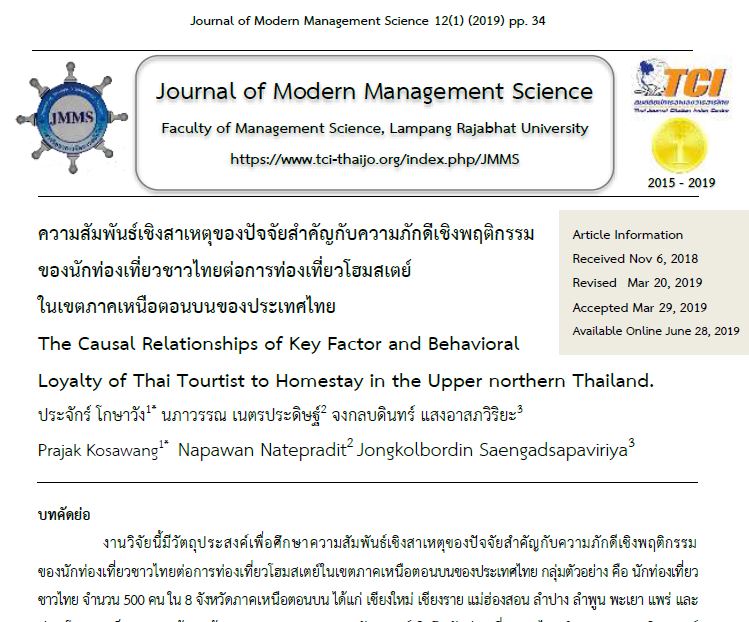The Causal Relationships of Key Factor and Behavioral Loyalty of Thai Tourtist to Homestay in the Upper northern Thailand.
Main Article Content
Abstract
The purpose of this research was to study the causal relationship of important factors and behavioral loyalty of Thai tourists towards Homestay tourism in the upper northern region of Thailand. The sample group was 500 Thai tourists in 8 upper northern provinces, namely Chiang Mai, Chiang Rai, Mae Hong Son, Lampang, Lamphun, Phayao, Phrae and Nan. The data collection used in-depth interviews with 20 Thai tourists. Quantitative data were analyzed by descriptive statistics to find the frequency, percentage, mean, a d standard deviation. The element analysis and structural equation models used qualitative data analysis by systematic summary method.
The results of the research showed that (1) the sample group had opinions on the Homestay image, perceived value, service quality, tourist satisfaction, and behavioral loyalty were at a high level (2) the image of the Homestay had a direct influence on the quality of service and perceived value. The Homestay image had an indirect influence on tourist satisfaction and behavioral loyalty. Service quality had a direct influence on tourist satisfaction and behavioral loyalty. Value perception had a direct influence on tourist satisfaction and behavioral loyalty. Tourist satisfaction had a direct influence on behavioral loyalty. Behavioral loyalty model of Homestay Tourists in the upper northern region was consistent with the empirical data.
Article Details
The article must be considered and accepted for publication by the editorial board of the Faculty of Management Science, Lampang Rajabhat University. The articles have been reviewed by a peer (peer review) and the author must update according to the suggestion if available before publication. Articles that are not considered the editorial team will inform the results of the consideration but will not send the original to the author.
JMMS is the Faculty of Management Science journal, Lampang Rajabhat University. Jmms published both print and online editions. We allow the use of articles for academic use under the scope of copyright law.
References
บุญเลิศ จิตตั้งวัฒนา. (2548). อุตสาหกรรมการท่องเที่ยว. กรุงเทพฯ: ศูนย์วิชาการท่องเที่ยวแห่งประเทศไทย.
มนัส สุวรรณ.(2549).ระเบียบวิธีวิจัยทางสังคมศาสตร์และมนุษย์ศาสตร์.กรุงเทพฯ: สำนักพิมพ์โอเดียนสโตร์.
วิวัฒน์ จันทร์กิ่งทอง. (2557). ทฤษฎีพฤติกรรมตามแผนกับความภักดีของนักท่องเที่ยว.
วารสารมหาวิทยาลัยศิลปากร ฉบับภาษาไทย, 34(2) : 131-146.
Ajzen, I. (1991). The theory of planned behavior. Organizational Behavior and Human Decision Processes, 50(2), 179-211.
Bigne, J. E., Mattila, A. S., & Andreu, L. (2008). The Impact of Experiential Consumption Cognitions and Emotions on Behavioral Intentions. Journal of Services Marketing, 22 (4), 303-315.
Boshoff, C., & Gray, B. (2004). The Relationships between Service Quality, Customer Satisfaction and Buying Intentions in the Private Hospital Industry. South African Journal of Business Management, 35(4), 27–37.
Chen, C. F., & Tsai, D. (2007). How Destination Image and Evaluative Factors Affect Behavioral Intentions? Tourism Management, 28 (4), 1115-1122.
Comrey, A. L., & Lee, H. B. (1992). A First Course in Factor Analysis. Hillsdale, New Jersey: Erlbaum.
Dodds, W. B., Monroe, K. B., & Grewal, D. (1991). The Effect of Price, Brand and Store Information
on Buyer's Product Evaluation. Journal of Marketing Research, 18, 39-50.
Echtner, C. M., & Ritchie, J. B. (2003). The Meaning and Measurement of Destination Image.
The Journal of Tourism Studies, 14 (1), 37-48.
Getty, J. M., & Thompson, K. N. (1994). The Relationship between Quality, Satisfaction, and Recommending Behavior in Lodging Decision. Journal of Hospitality & Leisure Marketing, 2(3), 3-22.
Kozak, M. & Decrop, A. (2009). Handbook of Tourist Behavior: Theory and Practice. New York: Routledge.
Lee, C. K., Lee, Y. K., & Lee, B. K. (2005). Korea’s Destination Image formed by the 2002 World Cup.
Annals of Tourism Research, 32(4), 839-858. Journal of Electronic Commerce, 11 (4), 11-51.
Li, X., & Petrick, J. F. (2010). Towards an Integrative Model of Loyalty Formation: The Role of Quality and Value. Leisure Sciences, 32(3), 201–221.
Likert, R. N. (1970). A technique for the measurement of attitude. Attitude Measurement.
Chicago: Ronal McNally & Company.
Noe, F. P., Uysal, M., & Magnini, V. P. (2010). Tourist Customer Service Satisfaction: An Encounter Approach. New York: Routledge.
Oliver, R. L. (1980). A cognitive Model of the Antecedents and Consequences of Satisfaction Decisions. Journal of Marketing Research, 17, 46-49.
Oliver, R.L. (1993). Cognitive, Affective, and Attribute Bases of the Satisfaction Response. Journal of Consumer Research, 20(3), 418-430.
Ozturk, A. B., & Qu, H. (2008). The Impact of Destination Images on Tourists' Perceived Value,
Expectations, and Loyalty. Journal of Quality Assurance in Hospitality and Tourism, 9(4),
275-297.
Parasuraman, A., Zeithaml, V. A., & Berry, L. L. (1985). A Conceptual Model of Service Quality and Its Implications for Future Research. Journal of Marketing, 49, 41-50.
Robinson, S., & Etherington, L. (2006). Customer loyalty: A Guide for Time Travelers. New York:
Palgrave Macmillan.
Saks, A. M., & Burke, L. A. (2012). An Investigation into the Relationship between Training Evaluation
and the Transfer of Training. International Journal of Training and Development, 16, 118–
127. doi:10.1111/j.1468-2419.2011.00397.x
Selnes, F. (1998). Antecedents and Consequences of Trust and Satisfaction in Buyer–seller Relationships. European Journal of Marketing, 32, 305-322.
Sweeney, J. C., & Soutar, G. N. (2001). Consumer Perceived Value: The Development of Multiple Item Scale. Journal of Retailing, 77(2), 203-220.
Tsiotsou, R. H. & Goldsmith, R. E. (2012). Strategic Marketing in Tourism Services. Bingley, UK: Emerald Group.
Woodruff, R. B. (1997). Customer Value: The Next Source for Competitive Advantage .Journal of Academy of Marketing Science, 25(2), 139-153.
Yin, R. K. (2003). Case study Research: Design and Method (3 ed) Thousand Oaks: Sage.
Zeithaml, V. A. (1988). Consumer Perceptions of Price, Quality and Value: A Means-end
Model and Synthesis of Evidence. Journal of Marketing, 52, 2-22.


